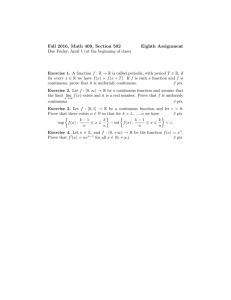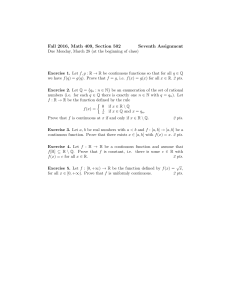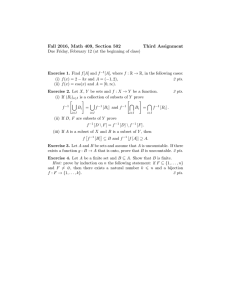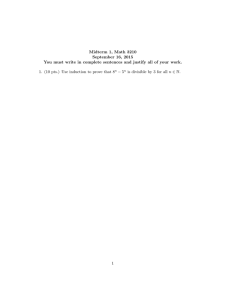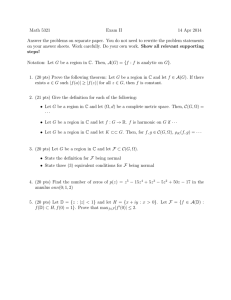Preliminary Exam: Probability 9:00am - 2:00pm, August 22, 2014
advertisement
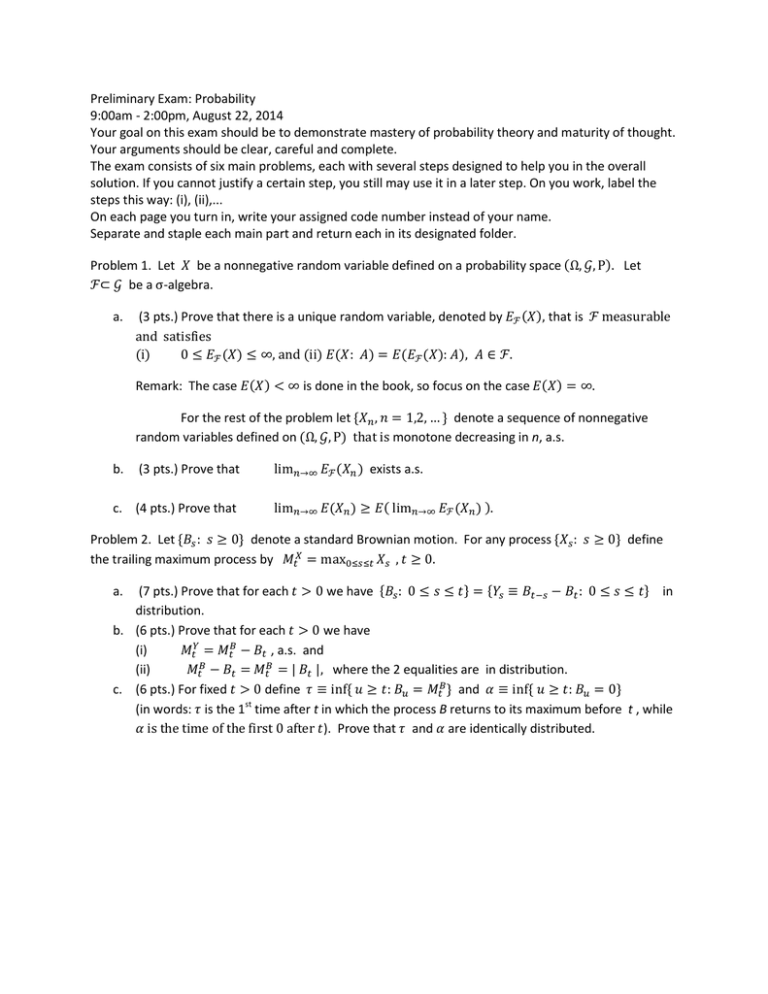
Preliminary Exam: Probability 9:00am - 2:00pm, August 22, 2014 Your goal on this exam should be to demonstrate mastery of probability theory and maturity of thought. Your arguments should be clear, careful and complete. The exam consists of six main problems, each with several steps designed to help you in the overall solution. If you cannot justify a certain step, you still may use it in a later step. On you work, label the steps this way: (i), (ii),... On each page you turn in, write your assigned code number instead of your name. Separate and staple each main part and return each in its designated folder. Problem 1. Let be a nonnegative random variable defined on a probability space ( ℱ be a σ-algebra. a. (3 pts.) Prove that there is a unique random variable, denoted by ℱ ( ) that is ℱ measurable and satisfies ) ( ℱ( ) ) (i) , and (ii) ( ℱ ℱ( ) Remark: The case ( ) is done in the book, so focus on the case ( ) For the rest of the problem let ) random variables defined on ( b. (3 pts.) Prove that c. (4 pts.) Prove that denote a sequence of nonnegative monotone decreasing in n, a.s. ℱ( ( ) exists a.s. ) ( ℱ( )) Problem 2. Let denote a standard Brownian motion. For any process the trailing maximum process by a. ) Let define (7 pts.) Prove that for each we have in distribution. b. (6 pts.) Prove that for each we have (i) , a.s. and (ii) where the 2 equalities are in distribution. c. (6 pts.) For fixed define and st (in words: is the 1 time after t in which the process B returns to its maximum before t , while ). Prove that and are identically distributed. Problem 3. Let Assume that ( a. denote a sequence of random variables defined on a probability space. ( ) ) (6 pts.) Assume that are identically distributed. Prove that | ⇒ √ are independent and identically distributed. Prove that | b. (6 pts.) Assume that ∏( where large ( √ ) ⇒ ). Hint: Use part a to justify the existence of ( and use an appropriate expansion of Problem 4. Let ⇒ if and only if ( For the rest of the problem assume ⇒ . Also, denote ( b. ) √ ) for . denote a sequence of random variables that are integer valued. (5 pts.) Prove that a. ( ) (5 pts.) Prove ∑ ( (i) ∑ ( (ii) ( ) ) Problem 5. Let random variables. ) . ) ⃗⃗⃗⃗⃗⃗⃗⃗⃗⃗⃗⃗⃗⃗ s denote a sequence of nonnegative, strictly stationary and ergodic a. (6 pts.) Let be a constant. Prove that the sequence stationary and ergodic. b. (6 pts.) Assume that Problem 6. Let filtration ℱ ℱ ( ). ⃗⃗⃗⃗⃗⃗⃗⃗⃗⃗⃗⃗⃗⃗ ∑ ( c. (5 pts.) Prove: ∑ ) ⃗⃗⃗⃗⃗⃗⃗⃗⃗⃗⃗⃗⃗⃗ ∑ ⃗⃗⃗⃗⃗⃗⃗⃗⃗⃗⃗⃗⃗⃗ , a.s. Prove that is strictly ( ) be a squared-integrable martingale sequence adapted to the a. (4 pts.) Prove that is submartingale with respect to (w.r.t) ℱ. b. (8 pts.) Doob’s decomposition says that there is a representation , where is a martingale w.r.t ℱ and is a sequence that is increasing in , predictable w.r.t ℱ (i.e. ℱ ) with . Show how to calculate and from .
